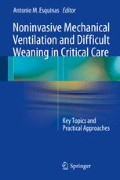Abstract
Optimal oxygen supply is the cornerstone of treatment of patients in critical condition, especially in patients at high risk of extubation failure. A high-flow nasal cannula is a relatively new device for delivery of heated and humidified medical gas mixtures at flow rates that exceed a patient’s inspiratory flow rate (Pilar et al., High flow oxygen therapy and continuous positive airway pressure. In: Medina A (ed) Non-invasive ventilation in pediatrics, pp 53–60, 2014; Lee et al. Intensive Care Med 39:247–257, 2013). The use of this device has been associated with improvements in washout of nasopharyngeal dead space; reduction of the inhalation resistance related to the passage of air through the nasopharyngeal airway; improvement in pulmonary compliance and elasticity compared with dry, cold gas; lung mucociliary clearance; and a certain degree of distending pressure for alveolar recruitment (Dysart et al. Respir Med 103:1400–1405, 2009). There are many experiences in the use of this device, mainly in neonatology and adult intensive care, including weaning from invasive ventilation.
Access this chapter
Tax calculation will be finalised at checkout
Purchases are for personal use only
Abbreviations
- CPAP:
-
Continuous positive airway pressure
- HFFM:
-
High-flow face mask
- HFNC:
-
High-flow nasal cannula
- HFNP:
-
High-flow nasal prongs
- HR:
-
Heart rate
- ICU:
-
Intensive care unit
- NCPAP:
-
Nasal continuous positive airway pressure
- NIV:
-
Noninvasive ventilation
- RR:
-
Respiratory rate
- WOB:
-
Work of breathing
References
Pilar J, Lopez Y, Morteruel E. High flow oxygen therapy and continuous positive airway pressure. In: Medina A, editor. Non-invasive ventilation in pediatrics. 2014. p. 53–60.
Lee JH, Rehder KJ, Williford L, Cheifetz IM, Turner DA. Use of high flow nasal cannula in critically ill infants, children, and adults: a critical review of the literature. 3rd edition ERGON Barcelona 2014. Intensive Care Med. 2013;39:247–57.
Dysart K, Miller TL, Wolfson MR, et al. Research in high flow therapy: mechanism of action. Respir Med. 2009;103:1400–5.
Hegde S, Prodhan P. Serious air leak syndrome complicating high-flow nasal cannula therapy: a report of 3 cases. Pediatrics. 2013;131:e1–6.
Mayfield S, Jauncey-Cooke J, Hough JL, et al. High flow nasal cannula therapy for respiratory support in children. Cochrane Database Syst Rev. 2014;3, CD009850.
Schibler A, Pham TM, Dunster KR, et al. Reduced intubation rates for infants after introduction of high flow nasal prong oxygen delivery. Intensive Care Med. 2011;37:847–52.
Milesi C, Baleine J, Matecki S, et al. Is treatment with a high flow nasal cannula effective in acute viral bronchiolitis? A physiologic study. Intensive Care Med. 2013;39:1088–94.
Manley BJ, Owen LS, Doyle LW, et al. High-flow nasal cannulae in very preterm infants after extubation. N Engl J Med. 2013;369:1425–33.
Collins CL, Holberton J, Barfield C, et al. A randomized controlled trial to compare heated humidified high-flow nasal cannulae with nasal continuous positive airway pressure postextubation in premature infants. J Pediatr. 2013;162:949–54.
Wilkinson D, Andersen C, O’Donnell C, et al. High flow nasal cannula for respiratory support in preterm infants. Cochrane Database Syst Rev. 2011;5, CD006405.
Testa G, Iodice F, Ricci Z, et al. Comparative evaluation of high-flow nasal cannula and conventional oxygen therapy in paediatric cardiac surgical patients: a randomized controlled trial. Interact Cardiovasc Thorac Surg. 2014;19:456–61.
Parke R, McGuinness S, Dixon R, et al. Open-label, phase II study of routine high-flow nasal oxygen therapy in cardiac surgical patients. Br J Anaesth. 2013;111:925–31.
Tiruvoipati R, Lewis D, Haji K, et al. High-flow nasal oxygen vs high-flow face mask: a randomized crossover trial in extubated patients. J Crit Care. 2010;25:463–8.
Rittayamai N, Tscheikuna J, Rujiwit P. High-flow nasal cannula versus conventional oxygen therapy after endotracheal extubation: a randomized crossover physiologic study. Respir Care. 2014;59:485–90.
Maggiore SM, Idone FA, Vaschetto R, et al. Nasal high-flow versus Venturi mask oxygen therapy after extubation effects on oxygenation, comfort, and clinical outcome. Am J Respir Crit Care Med. 2014;190:282–8.
Author information
Authors and Affiliations
Corresponding author
Editor information
Editors and Affiliations
Rights and permissions
Copyright information
© 2016 Springer International Publishing Switzerland
About this chapter
Cite this chapter
Pilar, F.J., Fernandez, Y.M.L. (2016). High-Flow Nasal Cannula Oxygen in Acute Respiratory Post-extubation Failure in Pediatric Patients: Key Practical Topics and Clinical Implications. In: Esquinas, A. (eds) Noninvasive Mechanical Ventilation and Difficult Weaning in Critical Care. Springer, Cham. https://doi.org/10.1007/978-3-319-04259-6_52
Download citation
DOI: https://doi.org/10.1007/978-3-319-04259-6_52
Publisher Name: Springer, Cham
Print ISBN: 978-3-319-04258-9
Online ISBN: 978-3-319-04259-6
eBook Packages: MedicineMedicine (R0)

